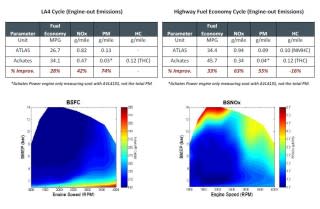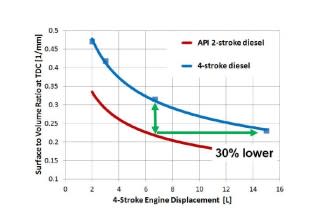Achates Closer To Production Of Radically Efficient Two-Stroke Truck Diesel
Suppose you could take an old engine concept discarded in the 1970s, add modern fuel metering and injection control hardware and software, and offer a compact powerplant that cuts the fuel consumption of today's diesel truck engines by a third..
That's the promise of Achates Power, which has been working for a decade on its horizontally opposed two-stroke diesel truck engine.
Now, it says, the company expects to announce its first pilot program with a global engine or vehicle maker within 18 months--almost surely outside the U.S.
And it hopes to have a large-scale production contract with a global maker by 2020 or so.

But why promote the engine now?
Largely because recent dynamometer tests of an Achates two-stroke engine in a full-size pickup truck have produced remarkable reductions in fuel consumption.
Achates says that against the most advanced four-stroke diesel engines, its design can cut fuel use by 30 percent--a significant amount when even an improvement of 0.1 mpg is considered worthwhile on CAFE testing.
DON'T MISS: China To Build EcoMotors' Efficient Opposed-Piston Engines (Apr 2013)
Started in 2004, Achates (pronounced "Ah-KAY-dees") has had test engines running for nine years now and has raised more than $100 million in venture capital.
By 2010, its prototypes had met current and future limits on emissions and fuel consumption--and the company published the results of its tests widely in target markets, including China and India as well as the U.S. and Europe.
It sees three sets of potential vehicle types that could use its technology: commercial, off-road, and passenger.
Since 1930s
The opposed-piston two-stroke engine has a history that's more than a century old, mostly in very large industrial applications.
Achates CEO David Johnson notes that the company's goal is to "bring a 1920s engine into the 2020s" using modern technology.

From the early 1930s, for instance, the Fairbanks-Morris company in Beloit, Wisconsin, sold opposed-piston designs 12 to 15 feet long and 10 feet high.
The 328-megawatt (440,000-horsepower) engines were used to power electric generators, offering the advantage of high power density for their size.
But two-stroke engines in general fell out of favor starting in the 1970s, for a variety of reasons.
ALSO SEE: Bill Gates Backs EcoMotors’ New OPOC Engine With $23.5 Million Investment (Jul 2010)
Those included not only the noise and vibration characteristics of two-stroke engines, but also their characteristic blue exhaust with a mix of combustion and engine-oil emissions.
Those emissions, in fact, are what led two-stroke engines to vanish from passenger cars by 1970.
Modern modeling, emission controls
Now, however, Achates says it has completely rethought the basic design--with 26 U.S. and 26 overseas patents granted, and another 90 or so in the pipeline.
Modern computer-aided design and combustion modeling, plus the latest high-pressure diesel fuel injection systems, cured many of the problems that had led the design to be viewed as a backwater.
Much of the work went into modern lubrication systems--no more mixing oil and fuel--and extensive, time-consuming combustion and structural modeling to reduce the noise and vibration from each combustion stroke.

The company also says it benefits greatly from fast-growing production of modern diesel aftertreatment systems, including selective catalytic reduction and particulate filters.
Those are now required to meet new and tougher European emission standards doing into effect this year for mass-market diesels, meaning they're no longer restricted to small volumes of North American vehicles.
Along with the high-pressure fuel injectors and pumps, plus the turbochargers used on all of today's diesels, the cost of diesel hardware is falling quick for third-party makers like Achates as global volume rises.

 Yahoo Autos
Yahoo Autos 
